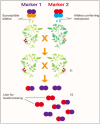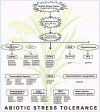Progressive Genomic Approaches to Explore Drought- and Salt-Induced Oxidative Stress Responses in Plants under Changing Climate
- PMID: 34579441
- PMCID: PMC8471759
- DOI: 10.3390/plants10091910
Progressive Genomic Approaches to Explore Drought- and Salt-Induced Oxidative Stress Responses in Plants under Changing Climate
Abstract
Drought and salinity are the major environmental abiotic stresses that negatively impact crop development and yield. To improve yields under abiotic stress conditions, drought- and salinity-tolerant crops are key to support world crop production and mitigate the demand of the growing world population. Nevertheless, plant responses to abiotic stresses are highly complex and controlled by networks of genetic and ecological factors that are the main targets of crop breeding programs. Several genomics strategies are employed to improve crop productivity under abiotic stress conditions, but traditional techniques are not sufficient to prevent stress-related losses in productivity. Within the last decade, modern genomics studies have advanced our capabilities of improving crop genetics, especially those traits relevant to abiotic stress management. This review provided updated and comprehensive knowledge concerning all possible combinations of advanced genomics tools and the gene regulatory network of reactive oxygen species homeostasis for the appropriate planning of future breeding programs, which will assist sustainable crop production under salinity and drought conditions.
Keywords: ROS; approaches; drought; genomics; integration; plants; salt.
Conflict of interest statement
The authors declare no conflict of interest.
Figures







References
-
- Athar H.R., Ashraf M. Salinity and Water Stress. Springer; Berlin/Heidelberg, Germany: 2009. Strategies for Crop Improvement against Salinity and Drought Stress: An Overview; pp. 1–16.
-
- Catlin P., Hoffman G., Mead R., Johnson R. Long-term response of mature plum trees to salinity. Irrig. Sci. 1993;13:171–176. doi: 10.1007/BF00190032. - DOI
Publication types
LinkOut - more resources
Full Text Sources

